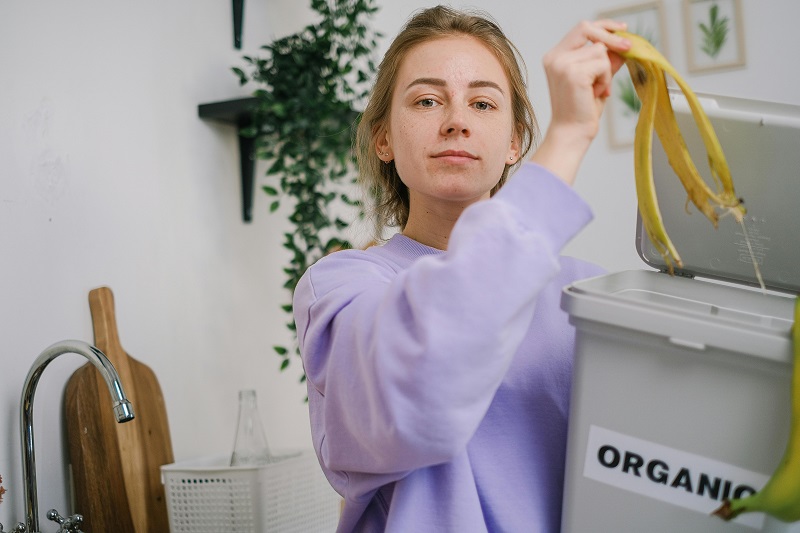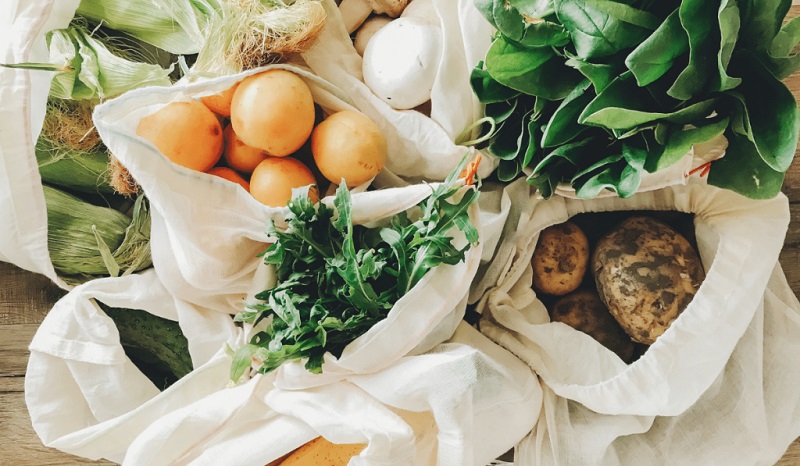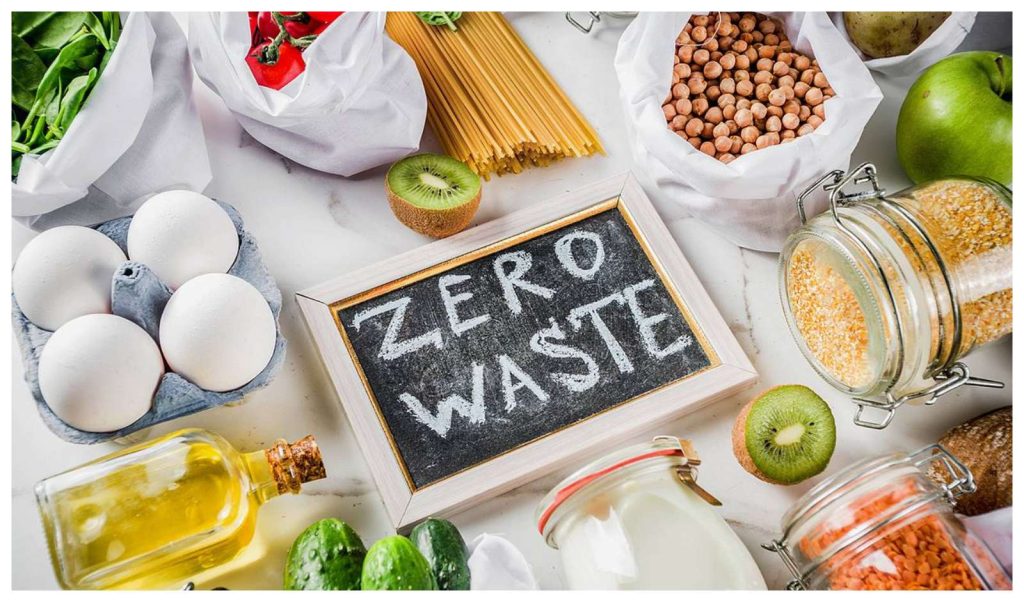Zero waste cooking is a practical approach to using every part of your ingredients while reducing food waste and saving money on groceries. This sustainable cooking method goes beyond simple recycling—it’s about creative meal planning, proper food storage, and transforming kitchen scraps into flavorful dishes. With approximately 30-40% of the U.S. food supply going to waste, adopting zero waste cooking practices helps your wallet, reduces your environmental impact, and brings more creativity to your kitchen.
What Is Zero Waste Cooking?
At its heart, zero waste cooking is a mindset. It’s about seeing potential in every part of an ingredient, from the carrot top down to its root. It’s a core component of broader holistic zero waste lifestyle tips that challenge us to be more mindful consumers. This practice applies the classic “three R’s” directly to your kitchen:
- Reduce: Buy less and use what you have.
- Reuse: Find creative new life for leftovers and food scraps.
- Recycle: Properly sort any packaging that does come into your home.
But it doesn’t stop there. It also embraces composting what you can’t eat. It’s not about achieving perfection overnight. Instead, it’s about making a series of small, smarter choices that add up, like using broccoli stems in a stir-fry, storing herbs correctly so they don’t wilt, and repurposing leftovers into an entirely new meal.
The Environmental and Economic Impact of Food Waste
The numbers behind food waste are staggering. In the United States, an estimated 30-40% of the entire food supply is thrown away. This food ends up in landfills, taking up about 24% of the space and releasing methane, a potent greenhouse gas, as it decomposes.
But this issue hits closer to home, too—right in our wallets. By reducing food waste, the average American family can save hundreds of dollars each year. When you use every part of the food you buy, you’re not just being environmentally responsible; you’re making a smart financial decision.
Core Principles of Zero Waste Cooking
To make this journey feel less overwhelming, I like to use the “5 R’s” framework in my kitchen:
- Refuse: Say no to what you don’t need, like single-use plastic produce bags, straws, and excessively packaged foods.
- Reduce: Buy only what you can realistically use. This starts with planning your meals and shopping with a list.
- Reuse: Repurpose everything you can. Glass jars become storage containers, and vegetable scraps become broth.
- Recycle: For the packaging you can’t avoid, make sure you know your local recycling rules and follow them.
- Rot: Compost your organic scraps. This turns unavoidable waste into nutrient-rich food for the soil, completing the cycle.

Setting Up Your Zero Waste Kitchen
Before you even start cooking, a little organization can make a huge difference. A well-organized kitchen is your best defense against forgotten food. I recommend creating a simple pantry inventory list so you know what you have before you shop.
Labeling leftovers and dry goods with dates is also a game-changer. My favorite trick is the “use-it-up” bin in the fridge. It’s a designated spot for produce that needs to be eaten soon. This visual cue helps me prioritize ingredients and prevents them from getting lost in the back of a drawer.
Essential Tools and Containers for Zero Waste Cooking
You don’t need to buy a bunch of fancy new gadgets. The goal is to reduce consumption, after all. Start with what you have and check out thrift stores for affordable additions. Here are a few essentials that make a big difference:
- Glass Jars: Perfect for storing everything from dry goods to leftovers and homemade broth.
- Beeswax Wraps: A great reusable alternative to plastic wrap for covering bowls or wrapping produce.
- Reusable Produce Bags: Keep these in your car or purse so you can refuse the plastic bags at the store.
- Metal or Glass Containers: Ideal for storing leftovers and packing lunches. They don’t stain or hold odors like plastic.
- A Small Compost Bin: A simple countertop container makes it easy to collect scraps as you cook.
Smart Shopping Strategies to Prevent Waste
Reducing waste begins at the grocery store. Going in with a plan is crucial. Here are some strategies that work for me:
- Plan Your Meals: Know what you’re going to eat for the week before you shop.
- Make a List (and Stick to It): This prevents impulse buys that often go to waste.
- Buy in Bulk: For pantry staples like beans, grains, and nuts, buying from bulk bins reduces packaging and often saves money.
- Shop Seasonally and Locally: Farmers markets are fantastic for fresh produce with minimal packaging.
- Choose “Imperfect” Produce: These fruits and veggies are perfectly fine to eat but are often overlooked, making them more likely to be wasted.
Zero Waste Meal Planning and Preparation
Effective meal planning is the foundation of a zero waste kitchen. I always start by “shopping” my own fridge, freezer, and pantry. What needs to be used up first? I build my meals around those items.
Ingredient overlap is your friend. Plan recipes that use similar ingredients, like using cilantro in both a curry and a salad dressing. I also love a “buy nothing new” meal challenge once a week, where I have to create a dish using only what I already have on hand. It’s a fun way to get creative and clear out the pantry.

Batch Cooking and Meal Prep Techniques
Batch cooking saves time, money, and mental energy during the week. I cook large batches of staples like rice, quinoa, and beans and store them in reusable containers in the fridge. This makes throwing together a quick lunch or dinner so much easier. You can also freeze portions for future meals, ensuring nothing goes to waste.
The FIFO Method: First In, First Out
This is a simple system used in restaurants that works wonders at home. FIFO just means you rotate your stock so that older items are moved to the front of your fridge and pantry, and new items go in the back. This ensures you use things up before they expire. It’s a small habit that dramatically reduces the chances of finding a forgotten, fuzzy container of something in the back of your fridge.
Root-to-Stem and Nose-to-Tail Cooking
This philosophy is about using the entire ingredient. For plants, this is called root-to-stem cooking. So many parts of vegetables that we typically throw away are not only edible but also delicious and packed with nutrients. Think broccoli stems, cauliflower cores, carrot tops, and beet greens.
A quick safety note: some plant parts are toxic, like rhubarb leaves and sprouted potato eyes, so always do a quick search if you’re unsure.
This approach isn’t about deprivation; it’s about abundance and creativity. You discover new flavors and textures while reducing your food waste to almost nothing.
Creative Ways to Use Vegetable Scraps
Once you start looking, you’ll find uses for everything. This is where having a good collection of plenty of zero waste recipes comes in handy. Here are some of my favorite ways to use common scraps:
- Carrot Tops: Blend them into a zesty pesto with garlic, nuts, and olive oil.
- Broccoli Stems: Shred them for a crunchy slaw or chop them finely and sauté.
- Cauliflower Cores: Chop and roast them right along with the florets.
- Beet Greens: Sauté them with a little garlic, just like you would with spinach or kale.
- Radish Leaves: They have a peppery bite that’s wonderful in salads.
Making Vegetable Broth from Kitchen Scraps
This is the ultimate zero waste kitchen hack. Keep a large bag or container in your freezer and add clean vegetable scraps to it throughout the week—think onion skins, carrot ends, celery tops, garlic peels, and herb stems.
Once the bag is full, simply empty it into a large pot, cover with water, add a bay leaf and some peppercorns, and simmer for at least an hour. Strain the liquid, and you have a rich, flavorful homemade broth for a fraction of the cost of store-bought versions.
Smart Food Storage to Extend Freshness
One of the biggest culprits of food waste is improper storage. If food spoils before you have a chance to eat it, your good intentions don’t matter much. Learning a few simple storage techniques is essential for a zero waste kitchen.

Refrigerator Storage Hacks
Your fridge can be a powerful tool for preserving food if you know how to use it.
- Wrap celery tightly in foil. It will stay crisp for weeks.
- Store salad greens with a paper towel in the container to absorb excess moisture.
- Keep herbs in a jar with a little water, like a bouquet of flowers.
- Revive wilted greens with a quick ice bath.
- Wash berries in a 3:1 water-to-vinegar solution before storing to prevent mold.
Freezer Techniques for Zero Waste
Your freezer is your best friend for long-term storage.
- Blend leafy greens with a little water and freeze in ice cube trays for easy smoothie additions.
- Chop herbs and freeze them in olive oil in ice cube trays for perfect “flavor bombs.”
- Peel and freeze overripe bananas for smoothies or “nice cream.”
- Freeze leftover sauces, coffee, and broths in portioned cubes.
Pantry Organization and Rotation
An organized pantry prevents you from buying things you already have. Store dry goods like beans, rice, and flour in clear, airtight containers so you can see what you have at a glance. Always practice the FIFO method, moving older items to the front to be used first.
Creative Ingredient Substitutions and Stretching Techniques
Being flexible in the kitchen helps reduce waste and saves money. You can often stretch expensive ingredients or substitute items you don’t have with a little creativity.
Stretching Proteins and Plant-Based Meats
You can easily make proteins go further. Bulk up plant-based ground meat with sautéed mushrooms, lentils, or beans. This not only doubles the volume but also adds extra nutrients and fiber. I also love adding cooked grains or white beans to dips like hummus to make them last longer.
Using Every Drop: Pasta Water, Bean Broth, and Pickle Brine
Some of the most flavorful liquids in the kitchen are often poured down the drain.
- Pasta Water: The starchy water is liquid gold for sauces. It helps emulsify and thicken a sauce, making it cling perfectly to the pasta.
- Bean Broth (Aquafaba): The liquid from a can of chickpeas can be whipped just like egg whites to make vegan meringue or mayonnaise.
- Pickle Brine: Don’t toss it! Use it to marinate tofu or quick-pickle fresh vegetables like onions and carrots.
Transforming Stale and Overripe Food
Food that seems past its prime often has a second life waiting.
- Stale Bread: Turns into amazing croutons, breadcrumbs, or a decadent bread pudding.
- Overripe Bananas: The best candidates for banana bread or freezing for smoothies.
- Mushy Avocados: Blend them into a surprisingly rich and creamy chocolate mousse.
- Wilting Greens: Perfect for tossing into soups, stews, or blending into pesto.
Leftover Transformation Strategies
The key to loving leftovers is to stop thinking of them as repeat meals and start seeing them as ingredients. This mental shift opens up a world of possibilities.

Classic Leftover Transformations
Some transformations are classics for a reason.
- Leftover Rice: The perfect base for fried rice. Just add veggies, a protein, and some soy sauce.
- Cooked Vegetables: Blend them with a little broth to create a creamy, delicious soup.
- Extra Pasta: Toss with olive oil and spices, then air-fry until crispy for “pasta chips.”
- Cooked Grains: Mix with plant milk, cinnamon, and a little sweetener for a quick breakfast porridge.
The “Girl Dinner” or Snack Plate Approach
This is my go-to for using up lots of little odds and ends. Assemble small portions of various leftovers—a scoop of hummus, a few roasted vegetables, some pickles, leftover bread—onto a single plate. It’s a satisfying, low-effort meal that prevents small amounts of food from going to waste.
Planned “Cook Once, Eat Twice” Meals
This is the art of intentional leftovers. When you’re making a soup, stew, or casserole, double the recipe. Freeze half of it immediately for a future meal. Weeks later, when you’ve forgotten about it, you’ll have a delicious, home-cooked meal ready to go. This is a key part of building a zero waste meal plan that works.
Making the Most of Almost-Empty Jars
That last little bit of peanut butter, mustard, or jam clinging to the inside of the jar is notoriously hard to get out. Instead of scraping it, use the jar itself as a mixing vessel.
Jar-Based Dressings and Sauces
This is one of my favorite kitchen hacks.
- Mustard or Jam Jar: Add oil, vinegar, salt, and pepper directly to the almost-empty jar. Shake vigorously for an instant vinaigrette.
- Tahini or Hummus Jar: Add lemon juice, water, and garlic. Shake for a creamy dressing.
- Peanut Butter Jar: Add soy sauce, rice vinegar, and a little sesame oil. Shake for a perfect peanut sauce.
Overnight Oats in Peanut Butter Jars
For a truly effortless breakfast, add rolled oats and your favorite plant milk directly to a nearly-empty peanut butter or almond butter jar. Stir or shake, then refrigerate overnight. In the morning, you’ll have delicious, protein-packed oatmeal ready to eat.
Composting: Completing the Zero Waste Cycle
For the food scraps that are truly inedible, composting is the final step. It’s the process of turning organic waste back into nutrient-rich soil. This diverts waste from landfills, reduces methane emissions, and creates a valuable resource for your garden or houseplants.

Composting Methods for Different Living Situations
You don’t need a huge yard to compost.
- Outdoor Bins: Perfect if you have yard space.
- Worm Bins (Vermicomposting): A great, odor-free option for apartments and small spaces.
- Bokashi: An indoor fermentation method that pickles your food scraps before they are buried.
- Community Drop-off: Many cities and farmers markets have compost collection sites. You can store your scraps in the freezer until you’re ready to make a drop-off.
What Can and Cannot Be Composted
A successful compost pile needs a balance of “greens” (nitrogen-rich) and “browns” (carbon-rich).
- Compost This (Greens): Fruit and vegetable scraps, coffee grounds, tea bags.
- Compost This (Browns): Crushed eggshells, nutshells, cardboard, paper, dried leaves.
- Avoid This: Meat, dairy, oily foods (these attract pests in backyard bins), and pet waste.
Managing and Maintaining Your Compost
Composting is simpler than it sounds. Your main jobs are to ensure the pile stays about as damp as a wrung-out sponge and to turn it occasionally to add air. If it starts to smell, it usually just means you need to add more “brown” materials like cardboard or dried leaves.
Zero Waste Cooking Benefits Beyond the Kitchen
The positive effects of zero waste cooking ripple outward. You save money, eat fresher whole foods, and reduce your exposure to chemicals from packaging. You also tap into a new well of creativity and feel a deep sense of satisfaction from being resourceful.
Supporting Local Food Systems
Zero waste practices naturally lead you toward local food sources like farmers markets and CSA (Community Supported Agriculture) programs. Buying local reduces transportation emissions, supports your community’s farmers, and often means your food comes with much less packaging.
Reducing Your Carbon Footprint Through Food Choices
Every time you prevent food from ending up in a landfill, you are preventing methane emissions. Every time you refuse packaging, you are reducing plastic pollution. Your daily choices in the kitchen are a powerful way to contribute to a healthier planet.
This journey is about progress, not perfection. Start with one or two new habits, and build from there. For more ideas on sustainable living, feel free to explore everything we have to offer here at www.notonetype.org.


You may also like this
Zero Waste Meal Plan: Your Complete Guide to Sustainable Eating
A zero waste meal plan is more than just deciding what to eat next week;...
Nov
Zero Waste Recipes: 15+ Easy Ideas to Reduce Food Waste
Hey everyone! I’ve found that some of the best meals come from being a little...
Nov
Zero Waste Challenge: Your Complete Guide to Sustainable Living
A zero waste challenge is a structured approach to dramatically reducing the amount of trash...
Nov
Simple Zero Waste Lifestyle Tips to Reduce Your Environmental Impact
Living a zero waste lifestyle might sound intense, but it’s really just a thoughtful approach...
Nov